The piece of the month of March 2021
ALTAR LECTERN. MONASTERY OF SANTA MARÍA LA REAL DE FITERO
José Ignacio Rodríguez
Doctor of Medicine and Surgery
The piece presented this month, an altar lectern, is a somewhat deteriorated work, due to which it was no longer used and fell into oblivion. Fortunately, Professor Ricardo Fernández Gracia brought to our attention knowledge the existence of this lectern, which is of great interest for being unique in its genre.
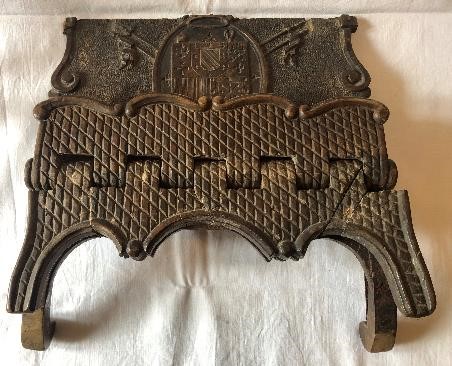
Altar lectern from the monastery of Fitero.
It is an altar lectern that was made for the use of the Cistercian monks of the monastery of Santa María la Real de Fitero. This fact, and the fact that it is decorated with an ecclesiastical coat of arms identified as that of the Cistercian Congregation of the Crown of Aragon and Navarre, as well as the fact that no other altar lecterns of the peninsular Cistercians are known, neither in Spain nor in Portugal, make it unique. It is also noteworthy that it is decorated with the coat of arms of the Congregation to which the monastery of Fitero was attached since 1631, both because very few examples of this coat of arms are preserved, and because it is the only one of the Navarre-Aragonese Cistercian Congregation that exists in Fitero, as can be seen in our recent review of its heraldry.
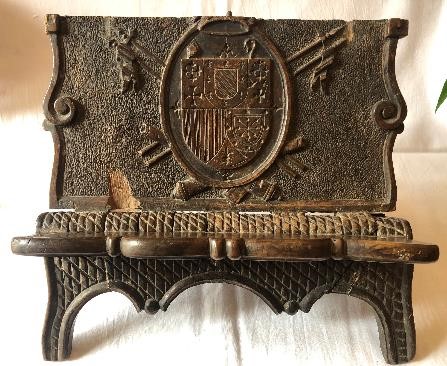
Altar lectern from the monastery of Fitero.
Made of wood, it has four scissor legs; the front ones, straight, joined by a triple arcade of profile convex, and the rear ones, curved. Rectangular skirt with lobed top, smooth on the obverse and incised rhomboidal grid decoration on the reverse, which continues in the body that joins the two front legs, and hinge as a cord. Rectangular back centered by the shield of the Cistercian Congregation of the Crown of Aragon and Navarre, without the crown of auction, whose polished surface contrasts with the work chopped on which it sits. This shield is framed by convex moldings in the form of scrolls located on the lateral edges.

Altar lectern from the monastery of Fitero.
The shield occupies the entire back, inscribed in an oval that had a crown as a crest, indicating the royal protection enjoyed by the Congregation, and has a mitre and a crosier in the bell as symbols of its high ecclesiastical hierarchy. In addition, a very significant detail is that the coat of arms is padded on a large flordelized cross of the Military Order of Calatrava, of which only the ends are visible. The field of the shield is split and has in the upper partition, in the center, in chief, the coat of arms of the Order of Cistercians, as described by Cocheril, bordered by the crosses of peninsular military orders: to its right a cross flordellisée (Order of Alcantara of Spain) and a cross kicked (Order of Christ of Portugal); and to its sinister a cross flordellisée on two birds (Order of Avis of Portugal) and a simple cross (Order of Montesa of Spain). In the lower partition of the shield are the royal arms of Aragon and Navarre and, in point, a fleur-de-lis.
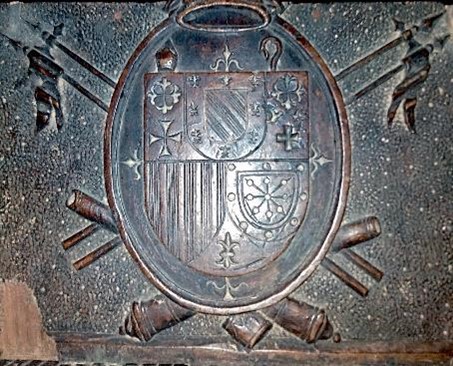
Coat of arms of the Cistercian Congregation of Navarra and Aragón on the lectern.
The training of the Congregation that grouped the Cistercian monasteries of Aragon, Catalonia, Valencia, Balearic Islands and Navarre was late (1631) and forced after long and strong pressures from the monarchy and the papacy. It was achieved that the monks and monasteries of Navarre and Aragon accepted to make reforms that had already been implemented for two centuries in the Cistercian monasteries of the Crown of Castile, but they were not able to dissociate themselves from the external control exercised from France by the general chapter of the Order of Cistercians, nor to stop obeying the abbot general of Citeaux. Knowing these circumstances, it is easy to understand what they wanted to express in their coat of arms, and the simplicity with which they showed the relationship they maintained with the Cistercian Order is astonishing. So that there would be no doubt that they continued to accept the authority of the Order, they placed the Citeaux coat of arms in the noblest part of the shield (in the upper area, in chief) and to specify that they were Spanish Cistercians, they placed the shield of the Congregation over a large cross of the Order of Calatrava, and next to the Citeaux shield they placed the crosses of the military orders of the Iberian Peninsula dependent on Calatrava, which were also of Cistercian obedience and followed the Rule of St. Benedict; In addition, to specify that they were monks and monasteries of different kingdoms, they placed the coat of arms of the Crown of Aragon and the kingdom of Navarre next to each other.
Thanks to De Pascual, we know that the last vicar general of the Cistercian Congregation of the Crown of Aragon and Navarre, Don Bruno Lafuente y Moreno (1813-1887), preserved after the disentailment a series of objects that were kept in the Cantabrian monastery of Viaceli, and that after their recovery and enhancement were deposited in Poblet, one of the monasteries still inhabited by Cistercians. Among these materials there is a form signed by the vicar general in 1875 that is stamped with a coat of arms of the Congregation, and also four stamps with the official coat of arms (two of them in bronze and two others in plaster). It is certain that the coat of arms on these stamps is the one that identified the Navarre-Aragonese Congregation, because they have a legend around them that specifies it and leaves no room for doubt:
SIGIL*CONGRE*CISTER*ORDINI*CORONA*ARAGONUM*E*NAVAR*
The coat of arms on the lectern of Fitero is identical to the one stamped on the aforementioned print and practically the same as the one on the preserved seals of the Congregation.
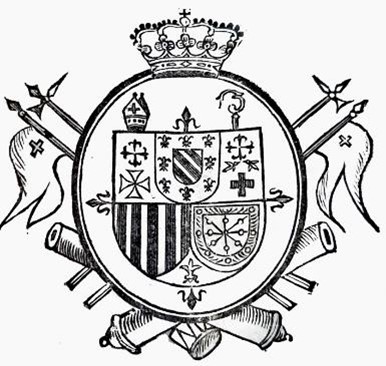
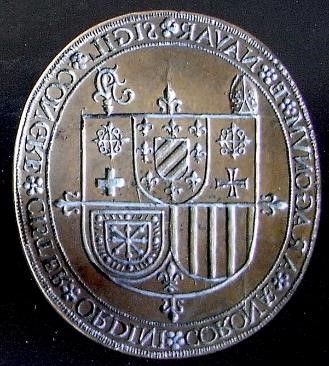
Left: coat of arms of the Cistercian Congregation of Navarre and Aragon on an official form. Right: coat of arms of the Cistercian Congregation of Navarre and Aragon on a bronze stamp.
on a bronze seal.
The two previous coats of arms, saving the obvious inequalities of the external decorations (royal crown and others) in one and the surrounding legend in the other, are quasi equal, but not identical. The differences are not in the coats of arms of Citeaux, Aragon and Navarre, which are the canonical ones, nor in the mitre and the crosier that carry the bell, nor in the flordelisé cross of the Order of Calatrava on which they are accolades. The divergences are found in the four crosses of the military orders next to the coat of arms of Citeaux; they are subtle variations, but transcendent in the symbolism and interpretation of the figures. Thus, they coincide in that there is a cross flordellisée without specific symbols (Order of Alcántara) to the right of Citeaux and in that there is a simple cross of the Order of Montesa below to the sinister; however, the other two crosses are not the same in both coats of arms. In the coat of arms of the print, the sinister flordellisée cross is surely the cross of the Portuguese Order of Avis for having two birds (as in the lectern), but in the coat of arms of the seal that cross has no specific symbols; the other difference is in the also Portuguese cross of the Order of Christ, which is triangular in one and kicked in the other. In our review of the crosses of military orders we have found that these are frequent ways of representing the Order of Christ in an atypical way, since this cross must have been potentiated.
These subtle variations led to inaccurate interpretations of the coat of arms by the two Spanish Cistercian heraldist monks who have dealt with the topic. In 1936, friar Amadeo García Rodríguez, monk of Viaceli, made an extraordinary pen drawing of the Map of Cistercian Spain in which he included, in the border that surrounds it, the coat of arms of the Cistercian Congregation of the Crown of Aragon and Navarre. This author, who must have known the documents of the vicar general kept in his monastery, drew the coat of arms of that Congregation as that of the seals, because he did not include the two little birds in the sinister flordellated cross. Fray Alberto Gómez González, monk of San Isidro de Dueñas (Palencia), had the enormous merit of making 20 years later, in 1956, the first revision of the Cistercian heraldry, in which he included a colored drawing of the coat of arms of the Navarre-Aragonese Congregation, stating that the drawing was a copy of a seal of the Congregation that he could see in a visit to Viaceli; he described it this way:
cut and half broken: the 1st of silver, on the whole of the Cistercian Order, embattled by the military crosses of Calatrava, Alcántara, Temple (! ?) and Montesa, the 2nd of gold and gules, which is of Aragon, the 3rd of gules, to the gold chain, which is of Navarre; in point, a golden lis on azure.
That is to say, that Friar Alberto in his copy obviated not only the external decorations that the seal's coat of arms has, but also, and this is the most transcendent thing, he eliminated the great cross of Calatrava (just as the other monk did) on which the coat of arms of the Congregation is mounted. As he only drew the figures that are inside the field and as the cross of Calatrava was obligatory, he considered that one of the two flordellated crosses was that of Calatrava (and, consequently, he drew it in red), while the other flordellated cross was assigned to Alcántara (and he drew it in green), thus excluding the cross of the Order of Avis. In addition, the triangular cross was not identified as belonging to the Order of Christ, but was assigned to the Temple, although with surprise ("¡") and doubt ("?"), because it was not an order of Cistercian obedience.

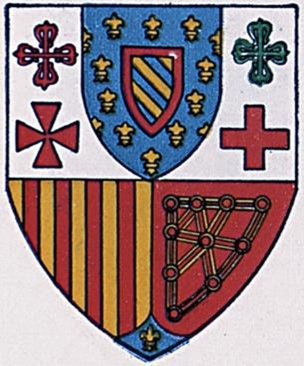
Left: pen drawing of the coat of arms of the Congregation of the Crown of Aragon and Navarre in the Map of Cistercian Spain by Friar García Rodríguez (1936). Right: colored drawing of the coat of arms of the Cistercian Congregation of the Crown of Aragon and Navarre, according to friar Gómez González (1956).
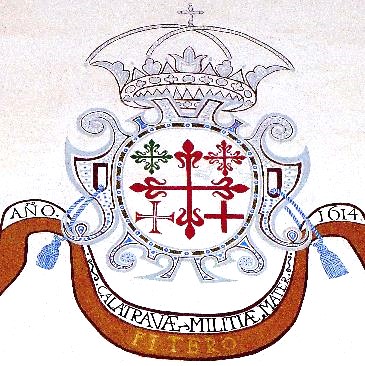

Left: cross of the Order of Calatrava surrounded by the crosses of Alcántara (in green) and Avis, Montesa and Christ in red, like the mother of the other Cistercian military orders. Painting on the Library Services of the monastery of Fitero. Right: cover of the Diffiniciones de la Orden y Caballeria de Calatrava (1660). Detail.
The heraldry preserved in the new Library Services of Fitero does not support the interpretation of the previous monks and does support the fact that the coat of arms of the Cistercian Congregation of the Crown of Aragon and Navarre has the crosses of the five main Cistercian military orders.
On the Library Services, which is located in the upper cloister, there are two painted coats of arms that are the same and are facing each other at the ends of the conference room; they are dated 1614, so they are prior to the training of the Congregation. The shields have 5 crosses. In the center is a large red flordellated cross (Calatrava) that is edged by four smaller crosses: the two at the top are flordellated, one green (Alcantara) and the other red with two little birds (Avis); and the two at the bottom are a red cross charged with a simple silver cross (Cristo típica) and the other is a simple red cross (Montesa). Each one of the shields has a motto with clear messages underneath; one recalls that the Order of Calatrava originated in Fitero and that this was the mother of the other orders(calatravae militiae mater. fitero) and the other recalls that St. Raymond was the first abbot and founder of Fitero and Calatrava in the year 1158(Huius fundator S. Raymundus. Primus Abbas Fiterii et Militiae Calatravae. A 1158).
The reading and interpretation of these five crosses seems simple, but it becomes complicated when noticing that there are two crosses with red flordellisadas. As by logic there is no doubt that the cross of greater size is that of Calatrava, the small one cannot also be Calatrava and even less if it has two little birds that are improper of that Order; therefore, the small red flordelisada corresponds to the cross of Avis that, instead of having its habitual green color, is red as it was in the beginnings of the Order, as Olival refers.
The iconography of the cover of the Diffiniciones de la Orden y Caballeria de Calatrava (Madrid, 1660) also supports that the shield of the Cistercian Congregation of the Crown of Aragon and Navarre includes the crosses of the five main Cistercian military orders with Calatrava in preeminent position. In that cover it is evident that below and united to the Calatrava shield there are two other equal shields of smaller size (Alcántara and Avis) and, of these, those of Montesa and Christ; the Calatrava shield has, in addition, royal crown and above a motto taken from Cant. 4,1: Mille clypei pendent ex ea omnis armatura fortium ("from the tower a thousand shields are pending, all of brave").
SOURCES AND BIBLIOGRAPHY
COCHERIL, M., "Sceaux et blasons", Collectanea Ordinis Cisterciensium Reformatorum, t. XIV, 1952, pp. 161-177. The Cistercian coat of arms has "the ancient arms of Burgundy placed over those of France. In the foreground are the arms of France: azure sown with fleurs-de-lis; in the second are the gold and azure bands of the Burgundy coat of arms; the third plane is the bordure of gules that has the previous one".
DE PASCUAL, F. R., "A purpose de un sello, archivos y report: grade aclaratoria", Cistercium, 275, 2020, pp. 123-129.
GÓMEZ GONZÁLEZ, M. A., "Heráldica Cisterciense Hispano-Lusitana", Hidalguía, 19, 1956, p. 873.
OLIVAL, F., "Cister e as Ordens Militares de Avis e Cristo (séculos XVI-XVIII)", in FERNANDES MARQUES, M. A. and AMARAL, L. C. (coords.), Monasticon (II): nos caminos de Cister. Livro do VII Encontro Cultural de São Cristóvão de Lafões, 2013, pp. 61-74.
RODRÍGUEZ, J. I., "Heráldica cisterciense en los monasterios de la Corona de Aragón y Navarra", Cistercium, 275, 2020, pp. 85-121.
RODRÍGUEZ, J. I., Crosses of military orders used by Cistercians and Benedictines in Spain and Portugal. Catalog-guide. Real Academia Matritense de Heráldica y Genealogía, Madrid, 2020, pp. 52-55.
